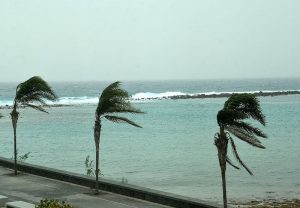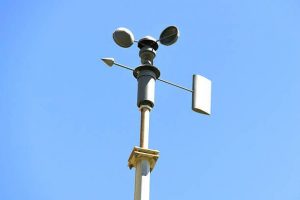Our planet is home to countless meteorological phenomena, many of them a product of the circulation of both internal and external energy that hits the planet from the Sun, one of them, well known, is: The Wind. This meteorological phenomenon is a very curious and relevant fact, but you know What is wind and how is it measured?
The wind is a natural phenomenon that in many cases we do not notice, it can be as close as it is as far away in matters of seconds, in the origins of the explanation of the things of our planet, it was believed that the wind was one of the four elements, of which all the matter on the planet earth, whether organic or not, was made up.

Wind can wreak havoc on Earth
However, this is a very limited concept for the wind phenomenon. There are several ways to appreciate this meteor. Once can become a gentle caress that combs your hair and slides down your face and, at other times, it can close in on you fast enough to take you hundreds of miles through the skies.
In this sense, according to the measurement of its speed we can say that the wind can be a delicate friend that greets you on a morning walk, as well as a ferocious unstoppable monster that can take cars, houses, and farms in its path. . Or if you have not seen the peculiar flying cow in tornadoes.
What is the wind phenomenon?
Wind is a flow of gases at large magnitudes. On planet Earth this phenomenon is the movement of variable and constant masses of air within the atmosphere, which circulates in a horizontal movement. Some meteorologists define its action due to the compensation of the different levels of atmospheric pressure between two determined points.
From the meteorological sciences, the phenomenon of winds is determined according to their strength and the direction from which they move. Sudden increases in wind speed for a short time are called bursts.
Winds of high intensity and speed but of intermediate duration, approximately one minute, are called squalls. Long-duration winds have various nomenclatures, in relation to their mean average strength, such as, for example, breeze, storm, storm, hurricane and typhoon.
This meteorological phenomenon can occur at various known scales: from stormy activities that can last for tens of minutes, as well as gradual breezes generated by the different heating of the rocky surface of the earth, said winds can last for several hours. ; even global winds, which are the result of the difference in absorption of solar energy between the different geoastronomical zones of the Earth, what at the beginning we called as external forces.
There are various forms of wind generation. Depending on the atmospheric circulation big scale they are the winds produced by the differential heating of the earth's surface depending on the latitude, as well as the inertia and centrifugal force produced by the planet's own rotational movement.
In the same way in the tropics, the circulation of the different thermal depressions above the ground and of the high plateaus it has the power to drive the circulation of large monsoons.
On the other hand, in coastal areas, the cycle generated between the breeze and the sea/land breeze can give character to the local winds, however, in areas of varied relief, the breezes from the valleys and mountains can determine the local winds.
Learn more about the subject here: 4 AMAZING FACTS ABOUT GRAVITY AT THE CENTER OF THE EARTH
displacement of the air in the lower area of the atmosphere, zone called: troposphere, is the most perceptive for human beings, this wind has two elements:
vertical element, which goes 10 kilometers or more and whose downward or upward movement compensates for the horizontal wind; and the horizontal element, which reaches hundreds of kilometers and is the most relevant of the two
If we carefully observe a tornado we can understand these concepts, because while its swirling structure begins to rotate at an extremely high speed, to the point of being destructive, and this same speed decreases as it the wind goes down, because the dimensions of the cone increase in the widest place, than in the narrowest.
What is the function of an Anemometer

Some instruments are more sophisticated than others
Considering that the wind is one of the great forces of nature, which can be of great benefit to living beings, the wind can also have great devastating power, so the need to measure its intensity is an important factor. for study and prediction.
Find out more by reading this article: 10 CURIOSITIES OF THE MILKY WAY THAT YOU CANNOT MISS
In this case the anemometer o anemograph It is a meteorological measuring instrument, which is used to measure wind speed and thus help in the prediction of climate change. This device also has great functionality in the flight of heavier than air aircraft, in this way the safe range of the flight and the most reliable route are determined.
In meteorology disciplines, cup or pinwheel anemometers are mainly used, which is in the shape of a tiny mill, which has three blades with cups on the which force acts of the wind at the moment of colliding with them, making it rotate. In this way, the number of laps recorded by the equipment can be read directly on a counter or recorded on a paper band, which is called an anemogram.
There are also devices that measure the speed of the wind that do not graph on paper, because these data are recorded and analyzed by a computer, which can forecast certain changes and variations in the wind that help in the accurate forecast of the weather. These equipments are electronic.
Expand this information here: HOW WERE THE FIRST MANNED TRIPS TO SPACE
The direction of the wind is also an important element to measure regarding climatic changes, in certain dates or seasons of the year, in this case a weather vane is used, which indicates the direction from which the wind comes, these data are recorded by their cardinal location.
Another instrument that serves to give a rudimentary indication of the direction and intensity of the miso is what is commonly called whirlwind. This low-tech instrument is mostly used at airports. It is a kind of fabric tube open on two sides and suspended above a pole.
Depending on the material, weight and conditions of the instrument, it is calibrated to record changes in the wind. If there is no wind, the sleeve remains in a vertical position, hanging from its pole. When the wind blows, it is placed in a more or less oblique position, and in the event that the wind is very strong, the sleeve will remain raised parallel to the ground.

The forerunner of the Wind measurement scale
To determine the intensity of the wind, the measurement scale par excellence is: Beaufort. This scale was created by Sir Francis Beaufort, who was an Irish naval officer and hydrographer, around the year 1805. By the year 1800 naval officers were making regular observations of the weather, but they did not have a measurement scale as such and the measurements were too subjective to understand. importance of it.